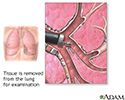Bronchoscopic culture
Culture - bronchoscopic
Bronchoscopic culture is a laboratory exam to check a piece of tissue or fluid from the lungs for infection-causing germs.
How the Test is Performed
A procedure called bronchoscopy is used to get a sample ( biopsy ) of lung tissue or fluid.
Bronchoscopy
Bronchoscopy is a test to view the airways and diagnose lung disease. It may also be used during the treatment of some lung conditions.

Biopsy
A biopsy is the removal of a small piece of tissue for laboratory examination.
The sample is sent to a laboratory. There, it is placed in a special dish (culture). It is then watched to see if bacteria or other disease-causing germs grow. Treatment is based on the results of the culture.
How to Prepare for the Test
Follow your health care provider's instructions on how to prepare for bronchoscopy.
How the Test will Feel
Your provider will tell you what to expect during bronchoscopy.
Why the Test is Performed
A bronchoscopic culture is done to find infection in the lung that cannot be accurately detected by a sputum culture . The procedure may find the following things, such as:
Sputum culture
Routine sputum culture is a laboratory test that looks for germs that cause infection. Sputum is the material that comes up from air passages when y...

- Abnormal secretions
- Abnormal lung tissue
-
Abscesses
Abscesses
An abscess is a collection of pus in any part of the body. In most cases, the area around an abscess is swollen and inflamed.
Read Article Now Book Mark Article - Inflammation
- Obstructive lesions, such as cancer or foreign bodies
Normal Results
No organisms are seen on the culture.
What Abnormal Results Mean
Abnormal culture results usually indicate a respiratory infection. The infection may be caused by bacteria, viruses, parasites, mycobacteria, or fungi. The results of the culture will help determine the best treatment.
Not all organisms found with bronchoscopic culture need to be treated. Your provider will tell you more about this if needed.
Risks
Your provider can discuss the risks of the bronchoscopy procedure with you.
References
Kupeli E, Feller-Kopman D, Mehta AC. Diagnostic bronchoscopy. In: Broaddus VC, Mason RJ, Ernst JD, et al, eds. Murray and Nadel's Textbook of Respiratory Medicine. 6th ed. Philadelphia, PA: Elsevier Saunders; 2016:chap 22.
Yung RC, Flint PW. Tracheobronchial endoscopy. In: Flint PW, Haughey BH, Lund V, et al, eds.
Cummings Otolaryngology: Head & Neck Surgery.
6th ed. Philadelphia, PA: Elsevier Mosby; 2015:chap 72.
-
Bronchoscopy - illustration
Bronchoscopy is a surgical technique for viewing the interior of the airways. Using sophisticated flexible fiber optic instruments, surgeons are able to explore the trachea, main stem bronchi, and some of the small bronchi. In children, this procedure may be used to remove foreign objects that have been inhaled. In adults, the procedure is most often used to take samples of (biopsy) suspicious lesions and for culturing specific areas in the lung.
Bronchoscopy
illustration
-
Bronchoscopic culture - illustration
A bronchoscopic culture is a laboratory test used to isolate and identify organisms that cause infection in the lungs. In order to perform the culture a sample of lung tissue or secretion from the lung is needed. A bronchoscope (a thin, flexible fiberoptic tube) is often used to obtain the lung tissue sample. Evidence of infection such as abscesses, inflammation, or abnormal secretions may be observed during the procedure.
Bronchoscopic culture
illustration
-
Bronchoscopy - illustration
Bronchoscopy is a surgical technique for viewing the interior of the airways. Using sophisticated flexible fiber optic instruments, surgeons are able to explore the trachea, main stem bronchi, and some of the small bronchi. In children, this procedure may be used to remove foreign objects that have been inhaled. In adults, the procedure is most often used to take samples of (biopsy) suspicious lesions and for culturing specific areas in the lung.
Bronchoscopy
illustration
-
Bronchoscopic culture - illustration
A bronchoscopic culture is a laboratory test used to isolate and identify organisms that cause infection in the lungs. In order to perform the culture a sample of lung tissue or secretion from the lung is needed. A bronchoscope (a thin, flexible fiberoptic tube) is often used to obtain the lung tissue sample. Evidence of infection such as abscesses, inflammation, or abnormal secretions may be observed during the procedure.
Bronchoscopic culture
illustration
Review Date: 11/19/2015
Reviewed By: Denis Hadjiliadis, MD, MHS, Associate Professor of Medicine, Pulmonary, Allergy, and Critical Care, Perelman School of Medicine, University of Pennsylvania, Philadelphia, PA. Also reviewed by David Zieve, MD, MHA, Isla Ogilvie, PhD, and the A.D.A.M. Editorial team.


